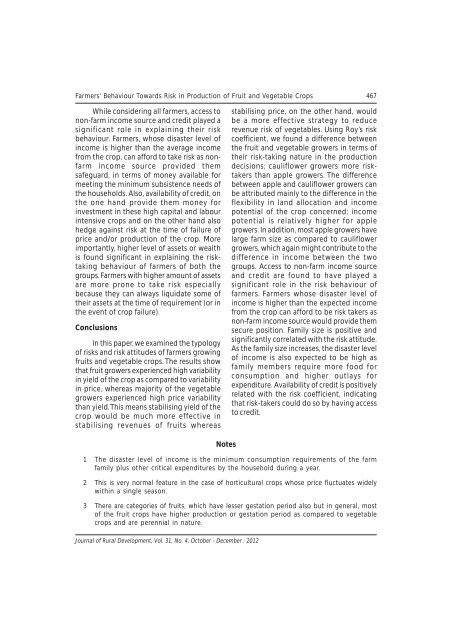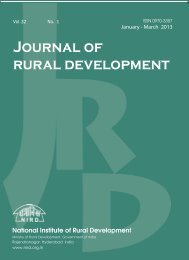October - December 2012 - National Institute of Rural Development
October - December 2012 - National Institute of Rural Development
October - December 2012 - National Institute of Rural Development
- No tags were found...
You also want an ePaper? Increase the reach of your titles
YUMPU automatically turns print PDFs into web optimized ePapers that Google loves.
Farmers' Behaviour Towards Risk in Production <strong>of</strong> Fruit and Vegetable Crops 467While considering all farmers, access tonon-farm income source and credit played asignificant role in explaining their riskbehaviour. Farmers, whose disaster level <strong>of</strong>income is higher than the average incomefrom the crop, can afford to take risk as nonfarmincome source provided themsafeguard, in terms <strong>of</strong> money available formeeting the minimum subsistence needs <strong>of</strong>the households. Also, availability <strong>of</strong> credit, onthe one hand provide them money forinvestment in these high capital and labourintensive crops and on the other hand alsohedge against risk at the time <strong>of</strong> failure <strong>of</strong>price and/or production <strong>of</strong> the crop. Moreimportantly, higher level <strong>of</strong> assets or wealthis found significant in explaining the risktakingbehaviour <strong>of</strong> farmers <strong>of</strong> both thegroups. Farmers with higher amount <strong>of</strong> assetsare more prone to take risk especiallybecause they can always liquidate some <strong>of</strong>their assets at the time <strong>of</strong> requirement (or inthe event <strong>of</strong> crop failure).ConclusionsIn this paper, we examined the typology<strong>of</strong> risks and risk attitudes <strong>of</strong> farmers growingfruits and vegetable crops. The results showthat fruit growers experienced high variabilityin yield <strong>of</strong> the crop as compared to variabilityin price, whereas majority <strong>of</strong> the vegetablegrowers experienced high price variabilitythan yield. This means stabilising yield <strong>of</strong> thecrop would be much more effective instabilising revenues <strong>of</strong> fruits whereasstabilising price, on the other hand, wouldbe a more effective strategy to reducerevenue risk <strong>of</strong> vegetables. Using Roy’s riskcoefficient, we found a difference betweenthe fruit and vegetable growers in terms <strong>of</strong>their risk-taking nature in the productiondecisions; cauliflower growers more risktakersthan apple growers. The differencebetween apple and cauliflower growers canbe attributed mainly to the difference in theflexibility in land allocation and incomepotential <strong>of</strong> the crop concerned; incomepotential is relatively higher for applegrowers. In addition, most apple growers havelarge farm size as compared to cauliflowergrowers, which again might contribute to thedifference in income between the twogroups. Access to non-farm income sourceand credit are found to have played asignificant role in the risk behaviour <strong>of</strong>farmers. Farmers whose disaster level <strong>of</strong>income is higher than the expected incomefrom the crop can afford to be risk takers asnon-farm income source would provide themsecure position. Family size is positive andsignificantly correlated with the risk attitude.As the family size increases, the disaster level<strong>of</strong> income is also expected to be high asfamily members require more food forconsumption and higher outlays forexpenditure. Availability <strong>of</strong> credit is positivelyrelated with the risk coefficient, indicatingthat risk-takers could do so by having accessto credit.Notes1 The disaster level <strong>of</strong> income is the minimum consumption requirements <strong>of</strong> the farmfamily plus other critical expenditures by the household during a year.2 This is very normal feature in the case <strong>of</strong> horticultural crops whose price fluctuates widelywithin a single season.3 There are categories <strong>of</strong> fruits, which have lesser gestation period also but in general, most<strong>of</strong> the fruit crops have higher production or gestation period as compared to vegetablecrops and are perennial in nature.Journal <strong>of</strong> <strong>Rural</strong> <strong>Development</strong>, Vol. 31, No. 4, <strong>October</strong> - <strong>December</strong> : <strong>2012</strong>

















